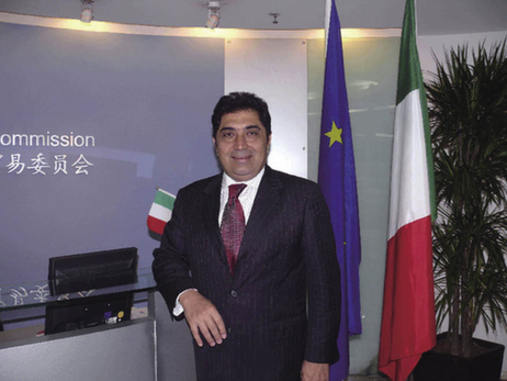| Antonio Laspina: Building Bridges Between China and Italy
By staff reporter ZENG PING
 |
| Antonio Laspina in his Beijing office. Zeng Ping |
CLAD in a dark-blue suit and a red tie, Antonio Laspina looks relaxed, smart and businesslike. “I’ve keenly felt the changes in China over the past seven or eight years,” he says, looking out over Beijing’s CBD from his 38th floor office in the Jingguang Center. Nothing encapsulates these changes better than this view over the burgeoning skyscrapers of China’s capital.
China-made vs. Italy-made
As the chief representative of the Italian Institute for Foreign Trade (Istituto nazionale per il Commercio Estero, or ICE) in Beijing, Antonio Laspina’s job is to sell famous Italian brands to Chinese consumers, while introducing Chinese manufacturers to Italy.
Laspina first came to China in the early 1980s. Previously he served as ICE trade commissioner in the Republic of Korea, Malaysia and China’s Taipei. During this period he visited the Chinese mainland several times. When he took up his position in Beijing in 2001, most Italian exports to China comprised machinery. Today Italian consumer goods such as furniture, jewelry and leather products can be seen in many large department stores around China. Of the ICE’s 1,000 trade promotions around the world each year, more than 150 are in China.
Laspina states frankly that most Italians associate “China-made” with quantity but not quality. “Though this generalization has exceptions,” he adds, “such as IT products and cashmere. But the best business suits and leather shoes made in China cannot be compared with those made in Italy, though they have their own customer base. In fact, it is not appropriate to draw comparisons between ‘China-made’ and ‘Italy-made,’ since we are at different stages of development, and competition is out of the question.”
Laspina warns that it might be presumptuous to talk about “China-created” when there is still a lot to do to change the world’s view of “China-made.” “It is imperative to enhance the standard of Chinese products, so people begin to buy them not because they are cheap, but because of their quality,” he urges.
Laspina speaks of Italian-made as a taste, a fusion of special production modes and a long history and culture, backed by thousands of brands, not just the few that are known in China. “Italy doesn’t only excel in fashion design and luxury goods,” says Laspina firmly.
In witnessing China’s rapid economic growth and changes in people’s lifestyles, Laspina has detected many business opportunities for Italian businesspeople. Citing an example, he says, “Beijing now has many ski fields in its suburbs, used by many locals.” The Italian side of the Alps contains a large skiing industry, which includes resorts, ski facilities and snow equipment manufacturers. Laspina and his office are promoting cooperation between Italian winter sports manufacturers and their Chinese counterparts.
Italy is the world’s largest wine producer and the second largest olive oil producer (after Spain). Laspina envisions Italy playing a large role in the steadily rising living standards of Chinese consumers. His country offers long-standing tradition combined with creativity, originality and adaptability.
Sinking into Beijing Life
Laspina has great respect for the Italian missionary Prospero Intorcetta (1625-1696), who centuries ago translated Confucius’ Zhongyong (Golden Mean) into Italian (Sinarum Scientia Politico-Moralis). He takes great pride in the fact that his hero was not only a fellow Sicilian, but also an alumni of the same school — albeit 400 years earlier.
Whenever Laspina returns to Sicily he looks for Intorcetta’s books and brings them back to China as gifts for Chinese friends. He has also suggested to the mayor of his hometown that a memorial be built to Intorcetta, so Sicilians will remember this pioneer of Italian-Chinese relations. He also hopes to raise Intorcetta’s profile in China, since the missionary is buried here.
Intorcetta’s love for China has touched Laspina, and being in Beijing for many years, he and his family have gradually become part of local society. Laspina’s second son studied in Beijing for four years. Though he is now back in Italy, he often calls to ask what is new in China’s capital. His youngest son — just 11 years old — has lived in China for five years and speaks the language fluently.
The more Laspina understands China, the more similarities he has found between his compatriots and the Chinese people — their love for family, the importance they attach to friendships, their creativity, and their attraction to new and adventurous endeavors. Laspina cannot help draw a comparison between Italians’ fondness for Chinese silk and porcelain 1,000 years ago, and the contemporary Chinese passion for Italian cars.
Laspina has many Chinese friends in Beijing, and often has parties at his home or goes on outings. But the first few years of his life in China were not like this. Initially he found locals kept a certain distance. With more and more foreigners living in Beijing, the local and expatriate communities have started to mingle and share their differences as well as similarities. For Laspina, like so may others, China has become an integral part of his life. | 